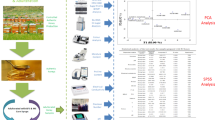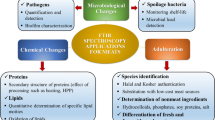Abstract
This study was focused on distinguishing of genetically modified organism (Monsanto 89788 variety) and conventional soybeans by employing high-resolution mass spectrometry (HRMS) techniques for non-target screening of sample extracts. Two hyphenated instrumental platforms represented by (i) ultrahigh-performance liquid chromatography (U-HPLC) coupled to quadrupole/time of flight and (ii) ambient mass spectrometry with direct analysis in real time (DART) ion source-coupled OrbitrapMS were used. The statistical processing of generated data (metabolomic fingerprints) was performed by multivariate data analysis; principal component analysis (PCA) and orthogonal partial least squares-discriminant analysis (OPLS-DA) showed that both employed techniques enabled correct classification of genetically modified and conventional soybeans. In addition, some phosphatidylcholines and sugars were identified as the most significant markers.





Similar content being viewed by others
References
Arun Ö, Yilmaz F, Muratoglu K (2013) PCR detection of genetically modified maize and soy in mildly and highly processed foods. Food Control 32:525–531
Berrueta LA, Alonso-Salces RM, Heberger K (2007) Supervised pattern recognition in food analysis. J Chromatogr A 1158:196–214
Blasco H, Blaszczynki J, Billaut J, Nadal-Desbarats L, Pradat P, Devos D, Moreau C, Andres C, Emond P, Corcia P, Slowinski (2015) Comparative analysis of targeted metabolomics: dominance-based rough set approach versus orthogonal partial least square-discriminant analysis. J Biomed Inform 53:291–299
Bylesjö M, Rantalainen M, Cloarec O, Nicholson JK, Holmes E, Trygg J (2006) OPLS discriminant analysis: combining the strengths of PLS-DA and SIMCA classification. J Chemom 20:341–351
Cajka T, Riddellova K, Tomaniova T, Hajslova J (2011) Ambient mass spectrometry employing a DART ion source for metabolomic fingerprinting/profiling: a powerful tool for beer origin recognition. Metabolomics 7:500–508
Cody RB, Laramee JA, Durst HD (2005) Versatile new ion source for the analysis of materials in open air under ambient conditions. Anal Chem 77:2297–2302
Cubero-Leon E, Peñalver R, Maquet A (2014) Review on metabolomics for food authentication. Food Res Int 60:95–107
Czarnak-Klos M, Rodríguez-Cerezo E (2010) Best practice documents for coexistence of genetically modified crops with conventional and organic farming. 1. Maize crop production. European Coexistence Bureau (ECoB). Institute for Prospective Technological Studies. Publications Office of the European Union, Luxembourg, 10, 4619
Del Gaudio S, Cirillo A, Di Bernardo G, Galderisi U, Cipollaro M (2012) Verification of real-time PCR methods for qualitative and quantitative testing of genetically modified organisms. J Food Qual 35:442–447
Devos Y, Aguilera J, Diveki Z, Gomes A, Liu Y, Paoletti C, Jardin P, Herman L, Perry JN, Waigmann E (2014) EFSA’s scientific activities and achievements on the risk assessment of genetically modified organisms (GMOs) during its first decade of existence: looking back and ahead. Transgenic Res 23:1–25
Dinon AZ, Treml D, Mello CS, Arisi ACM (2010) Monitoring of GMO in Brazilian processed meat and soy-based products from 2007 to 2008. J Food Compos Anal 23:226–229
EC (2003a) Regulation (EC) 1829/2003 of the European Parliament and of the Council of 22 September 2003 on genetically modified food and feed. Official Journal of the European 35 Communities L 268:1–23.36
EC (2003b) Regulation (EC) 1830/2003 of the European Parliament and of the Council of 22 September concerning the traceability and labelling of genetically modified organisms and the traceability of food and feed products produced from genetically modified organisms and amending. Repealing Council Directive 2001/18/EC. Official Journal of the European 35 Communities L 268:24–28.36
Hilbeck A, Weiss G, Oehen B, Römbke J, Jänsch S, Teichmann H, Lang A, Otto M, Tappeser B (2014) Ranking matrices as operational tools for the environmental risk assessment of genetically modified crops on non-target organisms. Ecol Indic 36:367–381
James C (2011) Executive summary of global status of commercialized biotech/GM crops: 2011. ISAAA Briefs No: 43, Ithaca
James C (2015) 20th anniversary (1996 to 2015) of the global commercialization of biotech crops and biotech crop highlights in 2015. (ISAAA Brief No. 51) Ithaca, NY. (http://www.isaaa.org/resources/publications/pocketk/16/. Accessed 24 April 2017, http://www.isaaa.org/resources/publications/briefs/51/executivesummary/default.asp. Accessed 24 April 2017)
Kim HS, Kim SK, Park YS, Kwon SY, Liu JR, Joung H, Jeon JH (2009) Metabolic profiles of genetically modified potatoes using a combination of metabolite fingerprinting and multivariate analysis. Biotechnol Bioprocess Eng 14:738–747
Krank J, Murphy RC, Barkley RM, Duchoslav E, MsAnoy A (2007) Qualitative analysis and quantitative assessment of changes in neutral glycerol lipid molecular species within cells. Methods Enzymol 432:1–20
Kusano M, Baxter I, Fukushima A, Oikawa Y, Nakabayashi R, Bouvrette DJ, Achard F, Jakubowski AR, Ballam JM et al (2015) Assessing metabolomic and chemical diversity of a soybean lineage representing 35 years of breeding. Metabolomics 11:261–270
Marrelli M, Tudisco R, Mastellone V, Conforti F (2013) A comparative study of phytochemical composition of genetically and nongenetically modified soybean (Glycine max L.) and evaluation of antitumor activity. Nat Prod Res 27:574–578
Mavropoulou AK, Koraki T, Ioannou PC, Christopoulos TK (2005) High-throughput double quantitative competitive polymerase chain reaction for determination of genetically modified organisms. Anal Chem 77:4785–4791
Nap JP, Metz PLJ, Escaler M, Conner AJ (2003) The release of genetically modified crops into the environment part I. Overview of current status and regulations. Plant J 33:1–18
Novotna H, Kmiecki O, Galazka M, Krtkova V, Hurajova A, Schulzova V, Hallmann E, Rembialkowska E, Hajslova J (2012) Metabolomic fingerprinting employing DART-TOFMS for authentication of tomatoes and peppers from organic and conventional farming. Food Additives and Contaminants: Part A 29:1335–1346
Ovesna J, Kucera L, Hodek J, Demnerova K (2010) Reliability of PCR based screening for identification and quantification of GMOs. Czech Journal of Food Science 28:133–138
Phipps RH, Park JR (2002) Environmental benefits of genetically modified crops: global and European perspectives on their ability to reduce pesticide use. J Anim Feed Sci 11:1–18
Rajan SR, Letourneau GK (2012) What risk assessments of genetically modified organisms can learn from institutional analyses of public health risks. J Biomed Biotechnol 2012:1–8
Rubert J, Zachariasova M, Hajslova J (2015) Advances in high-resolution mass spectrometry based on metabolomics studies for food—a review. Food Additives & Contaminants: Part A 32:1685–1708
Senior IJ, Dale PJ (2002) Herbicide-tolerant crops in agriculture: oilseed rape as a case study. Plant Breed 121:97–107
Simó C, Ibánez C, Valdés A, Cifuentes A, García-Canas V (2014) Metabolomics of genetically modified crops. Int J Mol Sci 15:18941–18966
Stewart S, Ivy MA, Anslyn EV (2014) The use of principal component analysis and discriminant analysis in differential sensing routines. Chem Soc Rev 43:70–84
Theodoridis GA, Gika HG, Want EJ, Wilson ID (2012) Liquid chromatography-mass spectrometry based global metabolite profiling: a review. Anal Chim Acta 711:7–16
Triba MN, Moyec LL, Amathieu R, Goossens C, Bouchemal N, Nahon P, Rutledgee DN, Savarina P (2015) PLS/OPLS models in metabolomics: the impact of permutation of dataset rows on the K-fold cross-validation quality parameters. Mol BioSyst 11:13–19
Tutelyan VA (2013) Genetically modified food sources safety assessment and control introduction, 1st edn. Elsevier INC, San Diego, pp 18–27
Ujhelyi G, Vajda B, Béki E, Neszlényi K, Jakab J, Jánosi A, Némedi E, Gelencsér É (2008) Surveying the RR soy content of commercially available food products in Hungary. Food Control 19:967–973
USDA National Agricultural Statistics Service, June Agricultural Survey for the years 2000–16. (https://www.ers.usda.gov/data-products/adoption-of-genetically-engineered-crops-in-the-us/recent-trends-in-ge-adoption.aspx. Accessed 24 April 2017)
Vaclavik L, Cajka T, Hrbek V, Hajslova J (2009) Ambient mass spectrometry employing direct analysis in real time (DART) ion source for olive oil quality and authenticity assessment. Anal Chim Acta 645:56–63
Vaclavik L, Rosmus J, Popping B, Hajslova J (2010) Rapid determination of melamine and cyanuric acid in milk powder using direct analysis in real time-time-of-flight mass spectrometry. Journal of Chromatography A 1217:4204–4211
Vaclavik L, Zachariasova M, Hrbek V, Hajslova J (2010) Analysis of multiple mycotoxins in cereals under ambient conditions using direct analysis in real time (DART) ionization coupled to high resolution mass spectrometry. Talanta 82:1950–1957
Vaclavik L, Ovesna J, Kucera L, Hodek J, Demnerova K, Hajslova J (2013) Application of ultra-high performance liquid chromatography-mass spectrometry (UHPLC-MS) metabolomic fingerprinting to characterise GM and conventional maize varieties. Czech Journal of Food Science 31:368–375
Worley B, Powers R (2013) Multivariate analysis in metabolomics. Current Metabolomics 1:92–107
Zhang D, Guo J (2011) The development and standardization of testing methods for genetically modified organisms and their derived products. J Integr Plant Biol 53:539–551
Zhao YY, Xiong Y, Curtis JM (2011) Measurement of phospholipids by hydrophilic interaction liquid chromatography coupled to tandem mass spectrometry: the determination of choline containing compounds in foods. J Chromatogr A 1218:5470–5479
Author information
Authors and Affiliations
Corresponding author
Ethics declarations
Funding
This work was supported by the Ministry of Agriculture of the Czech Republic (NAZV-QI101B267), Operational Programme Prague—Competitiveness (CZ.2.16/3.1.00/21537 and CZ.2.16/3.1.00/24503) and by the ‘National Program of Sustainability I’—NPU I (LO1601—No. MSMT-43760/2015). Josep Rubert thanks the Generalitat Valenciana (Conselleria d’Educació, Cultura i Esport) for the VALi + d postdoctoral fellowship ‘Contractació de personal investigador en formació en fase postdoctoral 2014’ (APOSTD/2014/120).
Conflict of Interest
Vojtech Hrbek declares that he/she has no conflict of interest. Veronika Krtkova declares that he/she has no conflict of interest. Josep Rubert declares that he/she has no conflict of interest. Hana Chmelarova declares that he/she has no conflict of interest. Katerina Demnerova declares that he/she has no conflict of interest. Jaroslava Ovesna declares that he/she has no conflict of interest. Jana Hajslova declares that he/she has no conflict of interest.
Compliance with Ethical Requirements
This article does not contain any studies with human participants or animals performed by any of the authors.
Informed Consent
Not applicable.
Electronic Supplementary Material
Figure S1
Examples of U-HPLC-ESI (+)-QTOFMS chromatographic records for free and bound forms of phytoestrogens present in soybean samples - 80% aqueous methanolic extract of conventional soybean sample. (TIFF 331 kb)
Figure S2
Permutation plots for the data obtained by U-HPLC-HRMS analysis of GMO and non-GMO soybean samples in both ionization modes. (TIFF 713 kb)
Figure S3
Permutation plots for the data obtained by DART-HRMS analysis of GMO and non-GMO soybean samples in both ionization modes. (TIFF 790 kb)
Figure S4
Chemometric analysis of data generated by LC-MS and DART-MS for conventional (grey), GMO (black) soybean samples and quality control (QC) samples (red triangles), PCA in positive and negative mode. (TIFF 992 kb)
Figure S5
S-plot of features (LC-ESI-HRMS analysis in positive mode) - ´markers´ with the highest importance for classification are highlighted in the black ovals. (TIFF 267 kb)
Figure S6
VIP plots for data obtained by both techniques in both ionization modes. (TIFF 356 kb)
Figure S7
Trend plots for data obtained by both techniques (LC-MS and DART-MS) in both ionization modes for conventional (grey) and GMO (black) soybean samples. (TIFF 1289 kb)
Rights and permissions
About this article
Cite this article
Hrbek, V., Krtkova, V., Rubert, J. et al. Metabolomic Strategies Based on High-Resolution Mass Spectrometry as a Tool for Recognition of GMO (MON 89788 Variety) and Non-GMO Soybean: a Critical Assessment of Two Complementary Methods. Food Anal. Methods 10, 3723–3737 (2017). https://doi.org/10.1007/s12161-017-0929-8
Received:
Accepted:
Published:
Issue Date:
DOI: https://doi.org/10.1007/s12161-017-0929-8




